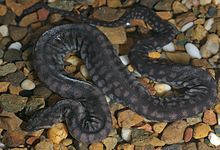Acrochordus arafurae
Appearance
| Acrochordus arafurae | |
|---|---|

| |
| Scientific classification | |
| Domain: | Eukaryota |
| Kingdom: | Animalia |
| Phylum: | Chordata |
| Class: | Reptilia |
| Order: | Squamata |
| Suborder: | Serpentes |
| Family: | Acrochordidae |
| Genus: | Acrochordus |
| Species: | A. arafurae
|
| Binomial name | |
| Acrochordus arafurae McDowell, 1979
| |
| Synonyms | |
| |
- Common names: Arafura File snake, Elephant Trunk Snake or wrinkle file snake.
Acrochordus arafurae is an aquatic snake species found in northern Australia and New Guinea. No subspecies are currently recognized.[3]
Description
Adults grown to 8.25 ft (2.5 m) in length.[4] They have amazingly loose skin and are known to prey on large fish, such as eel-tailed catfish. Females are usually larger than males and they have been known to give birth to up to 17 young. The indigenous peoples of northern Australia often hunt these snakes as they are quite common. As the snakes are near immobilized without the support of water the hunters merely throw each newly caught snake on the bank and continue hunting until they have enough. In New Guinea the skin is used to make drums.
See also
References
- ^ Template:IUCN2013.2
- ^ McDiarmid RW, Campbell JA, Touré T. 1999. Snake Species of the World: A Taxonomic and Geographic Reference, vol. 1. Herpetologists' League. 511 pp. ISBN 1-893777-00-6 (series). ISBN 1-893777-01-4 (volume).
- ^ "Acrochordus arafurae". Integrated Taxonomic Information System. Retrieved 16 August 2007.
- ^ Burnie D, Wilson DE. 2001. Animal. Dorling Kindersley. 624 pp. ISBN 0-7894-7764-5.
External links
- Acrochordus.com
- Species Acrochordus arafurae at The Reptile Database. Accessed 16 August 2007.
- Arafura Filesnakes at Life is Short but Snakes are Long

